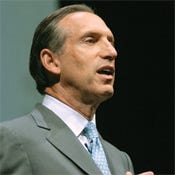Starbucks' CIO blends technology, marketing, and innovation, a winning formula in our annual recognition of IT leadership.

Download PDF of this article
Stephen Gillett was 32 years old when he took on the CIO job at Starbucks in 2008. Starbucks had gone from high-growth superstar to a company whose same-store sales were in decline--its stock price was down nearly 50% in less than two years. Gillett, with no retail experience, was now in charge of IT that supported a global supply chain and stores worldwide. The guy didn't even drink coffee until he started interviewing there.
Starbucks faced what Gillett now describes as a "technology debt." In racing to add about 2,300 stores over the previous three years, the company hadn't invested enough in in-store IT infrastructure. Its cash register system ran on DOS, so it took six weeks to train a new barista to get proficient on it. Store managers couldn't get email, because the one computer in each store processed credit cards, so it was locked down for regulatory compliance reasons. Starbucks had started work on its first global ERP system, and Gillett had to decide whether to push ahead.
Despite having all that work on his plate, Gillett made a pitch in early 2009 for even more responsibility. Howard Schultz, who returned as CEO in 2008 to turn things around, had told company executives after the 2008 holiday season to come back in the new year with some big ideas. He had urged them to think beyond their own corporate functions.
Gillett pitched the Starbucks executive council on what he called startup funding--a "series A" venture capital investment in a new business unit called Digital Ventures. It wouldn't live in either IT or marketing, Gillett said, but would work closely with both to bring new services to Starbucks customers through smartphones, tablets, and laptops.
Gillett got the go-ahead, and to run Digital Ventures, he hired Adam Brotman, his former co-worker and an entrepreneur who ran several e-commerce businesses. Since creating Digital Ventures, Starbucks has become a retail leader in mobile payments. Gillett's digital and IT teams also have improved the company's loyalty card system, in part by developing smartphone apps that complement the loyalty cards. They created a digital network in the U.S. that offers free in-store Wi-Fi, as well as content that customers would normally have to pay for.
Starbucks' marketing and IT organizations work closely on all of those efforts--it was the digital marketing team, for example, that came up with the idea to do a smartphone app that, when the camera's pointed at one of the retailer's iconic red holiday cups, shows a character that looks like it's skating or otherwise moving on the cup (How Starbucks Blends Marketing And Tech). But Digital Ventures is meant to drive the company's broader Web and mobile strategies.

How Starbucks Taps 7 Tech Trends
Stephen Gillett (click image for slideshow: How Starbucks Taps 7 Tech Trends)
"If I take the digital capability and put it under engineering or IT, even with the best of intentions, it becomes heavily influenced by the technology initiatives," Gillett says. "And if I take the same function and put it under a marketing function, it will inherently be dictated by the cadence of a marketing campaign. We needed it to have the autonomy of its own destiny, of its own vision."
For making technology a much bigger part of the Starbucks customer experience, while also helping the company improve its operations and processes, Stephen Gillett has earned recognition as InformationWeek's 2011 Chief of the Year.
His work isn't done. Starbucks still needs to roll out many of its tech implementations globally. It just last month launched an IT support operation that looks like an Apple Store, which Gillett hopes will draw out new IT ideas from employees (Starbucks' Help Desk Secret: Model An Apple Store). The company needs deeper digital relationships with its customers. But Starbucks has paid down a lot of that "technology debt" it had built up during its growth surge and is embarking on some bold IT-driven initiatives.
More CIO Of The Year: 
Problem At The Cash Register
Gillett spent his first week at Starbucks in 2008 working in a store. "I'm literally warped back into my youth," he recalls, "where I'm using a DOS shell, and the last major release of it was going from grayscale to four different color tones."
Starbucks' leaders knew the limits of the point-of-sale system, but when the company was focused on opening stores daily, IT's role was to mitigate risk and support that growth, says Curt Garner, senior VP of business technology and a Starbucks IT veteran who in 2008 was asked to take over technology used to run the stores. Of the group's roughly 160 tech projects at the time, "only one or two had anything to do with stores or customers," Garner says. "The majority were focused on how we keep the growth engine going."
Starbucks' problems in 2008 were highly public, thanks to Schultz's return as CEO and the company's decision to close 600 underperforming stores and make the first major layoffs in its history. There was no shortage of IT vendors bombarding Schultz, Gillett, and other Starbucks executives with ideas for how to use tech to transform the company. So about six months after joining Starbucks, Gillett held a "tech derby" to give the executive leaders a very visual summary of what the IT organization was thinking about and get consensus on what should be its top priorities.
At one display at the derby, a barista took an executive's order, and as she did so, the point-of-sale screen she used was simultaneously shown on a large-screen display, for the executives to see. With the existing system, baristas had to translate orders into machine-speak: size first, then drink type, then add-ons, regardless of how the customer said it. The proposed system, which IT had mocked up as a demo, would allow "conversational ordering"--if the customer said "soy latte grande with one pump vanilla," that's how a barista could punch it in.
When they showed both to Schultz, "he just turned around and said 'When? And whatever you're going to tell me, it has to be faster,'" Garner recalls. Starbucks has deployed the system in the U.S., Canada, the U.K., and Ireland and plans to roll it out internationally throughout the coming year.
Another tech derby proposal was to give laptops to store managers. Each store at the time had a single PC, but it was linked to the POS system, so it couldn't include Microsoft Office or email because of PCI rules for processing credit cards.
The derby showed ways to use those laptops for processing employee applications (then done on paper), scheduling work shifts (also on paper), and conducting training. At the time, people who applied for work at one Starbucks filled out a paper form and then filled out the same form if they applied at a store a half mile away. Starbucks equipped 10,000 stores with new laptops. It has online applications live in the U.S. and Canada and is piloting online labor scheduling. It's also giving store managers in the U.S., U.K., and Canada email and productivity apps on those laptops, via Microsoft's Office 365 cloud-based service.
Before Starbucks, Gillett had never worked on the physical scale of a Starbucks. He had a two-year stint as CIO of Corbis, which provides digital photos and video for advertisers and other media outlets. Owned by its chairman, Bill Gates, Corbis is a global e-commerce operation but has just 650 employees, compared with Starbucks' 149,000. Before Corbis, Gillett held a senior engineering management position at Yahoo, was VP of IS for CNET, and was an IT director at Sun.
While Gillett had a lot to learn about retail, he thinks it helped to look at a string of retail stores as one big computer network. "Big software, like Sun, and big Internet, like Yahoo, had solved a lot of the technical challenges that big retail had yet to solve," Gillett says. "... If you think of all your stores like nodes on a network, and all your registers as computers rather than cash registers, you can start to manage and deploy and operate that like Yahoo would a server farm, as CNET would a data center."
Lessons From A Gamer
The most interesting bits on Gillett's resume, though, aren't his stints at various tech companies. He played guard on the University of Oregon's football team, for example. But one accomplishment pops out from the rest: guild master in World of Warcraft, the online role-playing game where players enter a fantasy world of warriors, monsters, and quests. Being a guild master means he convinced other players to follow him on quests.
Now, if you're a conspicuously young C-level executive for a Fortune 500 company facing a crisis, you might be inclined to play down just how much of your life has been devoted to playing video games. But Gillett took the opposite approach: He dragged Schultz and other top execs to Activision Blizzard, the company that owns the World of Warcraft franchise. Blizzard has the same kind of passion for its business that Starbucks does, Gillett argued, and it sparks a similar passion with its customers. And by the way, it was growing revenue in a recession that was killing Starbucks.
World of Warcraft also had hordes of fans in a young and male demographic, where Starbucks was weak. Gillett knew Starbucks needed to engage customers online in a much more compelling way, to make its online environment as uniquely welcoming as its stores. Was there something Starbucks and Blizzard could do together, Gillett wondered, maybe even offer free gaming over Starbucks' in-store Wi-Fi network?
The executives spent a day together, but a partnership didn't pan out. The gap between the calm of a Starbucks shop and the carnage of an orc-strewn World of Warcraft battlefield proved too big.
But something big came of thinking differently. Brotman, senior VP and the Starbucks Digital Ventures general manager, asked Gillett: If Blizzard considered giving away some of its precious content to reach the Starbucks audience, who else might do the same? "Adam and I made a list, we split it in two, and he cold-called half and I cold-called half," Gillett says. Starbucks now offers The Wall Street Journal, Zagat restaurant reviews, The Economist, Marvel comic books, and more for free on an online portal available in U.S. stores, along with select free music downloads from iTunes.
"The big debate was, do we put the digital network on screens and add 50- inch plasmas to every store?" Gillett says. "The decision I came to was, we need to build the experience on the screens people are already bringing into our stores."

CEO Howard Shultz
"Upon my return as CEO, it became apparent that Starbucks needed to overhaul its aging technology infrastructure," CEO Howard Shultz says. Gillett brought tech acumen and digital media knowledge, and had an "insatiable curiosity and wasn't afraid of pursuing big, bold ideas."The Starbucks Digital Network portal was designed with the iPad in mind: Customers would access the network's content through Starbucks sites that are touchable and swipable, while also working great on a laptop. But here's the catch: The Digital Ventures group designed the network in 2009; the iPad wasn't released until early 2010, and Starbucks had no inside knowledge what it would be like.
"We were guessing what the iPad would be like," Brotman says. "We literally were watching those videos everyone else was watching on YouTube, where people were guessing what the tablet would look like."
Digital Ventures was built with this kind of rapid pace of change and innovation in mind. It was meant to make Starbucks more entrepreneurial and better able to respond quickly to new opportunities. But bigger tests still lie ahead.
Loyalty And Mobility
By 2008, it became clear that Starbucks was missing a big opportunity to connect with customers because it didn't have a strong loyalty card program. In early 2008 it had launched an online social media platform called My Starbucks Idea, based on Salesforce.com's Ideas software service, to let people publicly post ideas for products and new offerings, and let others vote them up or down. The most common suggestions were to offer a better loyalty card program and do more with mobile. Before the loyalty card, the only program Starbucks had was its $25 gift card, which gave customers 10% discounts. "Whether you came once a year or 20 times a month, the benefits were exactly the same," Garner says.
The loyalty program it launched in 2008, My Starbucks Rewards, recognized customers based on their number of visits. But the program is paying off even more--for Starbucks and customers--with the addition of an app and mobile payments.
The payment app, launched this year in the U.S. and Canada, lets people see how many visits they need to get a free drink, and it also lets people reload the app from a credit card. If a customer uses a credit card to reload $25 on the app, it saves a barista the time of reloading a card and it saves Starbucks' credit card fees for every transaction. The mobile app also lets people send electronic gift cards, as does a Starbucks e-gift feature on Facebook launched in January. Those features should help solidify Starbucks cards as a go-to, last-minute gift: People already buy more Starbucks gift cards on Christmas than any other day.
At a time when most retailers are waiting to see what technology and payment-processing standards will win around the "mobile wallet," Starbucks has completed more than 20 million transactions through its mobile payment app this year. It added Android support in June (while recently ending new BlackBerry downloads, as it evaluates support for the platform).
To support mobile payments, Starbucks installed 2-D bar code readers in its U.S. stores, letting customers scan their smartphones to make payments. Gillett makes it clear that Starbucks has no loyalty to that technology or standard, describing 2-D bar codes as merely the easiest and most readily available option. He expects near-field communication, for example, to become prominent as that technology advances.
Next: 'Contextual Retailing'
Despite its connections via loyalty cards, mobile apps, and Wi-Fi network, Starbucks still has relatively shallow relationships with its customers when it comes to digital, considering the passionate people who "grab a Starbucks" every day and know their baristas by name.
Expect that to change in 2012, when Starbucks starts using a Siebel CRM system it implemented this year. "We're now officially in the world of big data," says Gillett, declining to say just how much data that entails.
Starbucks hasn't laid out how it will use its better customer data for marketing. The Siebel system could, for instance, let Starbucks offer loyal customers a promotion for a drink they've never tried before and then track how often they bought that item again. Or the data could let Starbucks send promotions to once-steady customers who haven't visited lately.
In general, though, Gillett thinks retail has a long way to go with personalization. He calls the idea "contextual retailing," where the store experience depends on who is in it. (He wrote about the idea on his blog (see: The Guild CIO).
You can see tiny pieces today of what Gillett envisions. The Starbucks Digital Network knows what store you're in, based on the Wi-Fi network, so the news and weather is local, and the Zagat reviews are of nearby restaurants. But what if you chose to let the store know much more about you, based on your loyalty card purchases? You could, in theory, even choose to let a store's IT system know about you as you walk in the door.
"When I walk into a store, how does the store itself, the ethos of the store, know that I'm there," Gillett asks, "and tailor my experience in that store to me, in a way that's appropriate for the overall experience?"
Should a store's selection of music, for example, consider the preferences of all the people in the store? Does the barista know as you walk up that you're a regular in your midtown Manhattan store but you're visiting this Seattle Starbucks for the first time--so that he can welcome you with something you've never tried? None of that happens today, but it may be possible. "However that manifests is what I think is the Holy Grail of retail, in terms of bringing context to your experience," Gillett says.
Starbucks' transformation under Schultz seems to be working. Same store sales are growing again--up 8% this fiscal year--with operating margins also rising, up 1.5 points to 14.8%.
Schultz says he tapped Gillett in 2008 for his tech and digital media acumen, his "insatiable curiosity," but also because he "wasn't afraid of pursuing big, bold ideas." Gillett and his team have delivered some of those, from mobile payments to free Wi-Fi and content. With a new tech foundation in place, look for more such moves in the coming year.
More CIO Of The Year: 

InformationWeek: Dec. 12, 2010 Issue
Download a free PDF of InformationWeek magazine
(registration required)
About the Author(s)
You May Also Like







